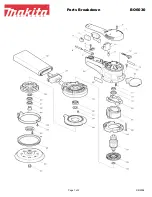
-40-
Model G0819 (Mfd. Since 09/16)
Review the troubleshooting and procedures in this section if a problem develops with your machine. If
you need replacement parts or additional help with a procedure, call our Technical Support.
Note: Please
gather the serial number and manufacture date of your machine before calling.
SECTION 7: SERVICE
Troubleshooting
Motor & Electrical
Symptom
Possible Cause
Possible Solution
Machine does
not start or a
breaker trips.
1. Emergency stop button depressed/at fault.
2. Emergency stop panel depressed/at fault.
3. Incorrect power supply voltage or circuit size.
4. Power supply circuit breaker tripped or fuse
blown.
5. Motor wires connected incorrectly.
6. Wiring open/has high resistance.
7. Sanding belt position limit switch engaged/at
fault.
8. ON/OFF switch at fault.
9. Start capacitor at fault.
10. Thermal overload relay has tripped.
11. Contactor not energized/has poor contacts.
12. Motor at fault.
13. Sanding depth too great.
1. Rotate button clockwise to reset. Replace if at fault.
2. Disengage stop panel. Replace if at fault.
3. Ensure correct power supply voltage and circuit size
(
Page 61).
4. Ensure circuit is sized correctly and free of shorts.
Reset circuit breaker or replace fuse.
5. Correct motor wiring connections (
Page 65).
6. Check/fix broken, disconnected, or corroded wires.
7. Correct sanding belt oscillation (
Page 43
); replace
faulty switch.
8. Replace switch.
9. Test/replace.
10. Allow to cool, then reset; replace.
11. Test all legs for power/replace if at fault.
12. Test/repair/replace.
13. Reduce sanding depth.
Machine
stalls or is
underpowered.
1. Feed rate/cutting speed too fast for task.
2. Workpiece material is not suitable for this
machine.
3. Belt(s) slipping; oil/grease on belt(s).
4. Motor overheated.
5. Motor wired incorrectly.
6. Motor bearings at fault.
7. Contactor not energized/has poor contacts.
8. Motor is at fault.
1. Decrease feed rate/cutting speed.
2. Only sand wood; ensure moisture is below 20% and
there are no foreign materials in the workpiece.
3. Clean/tension/replace belt(s); align pulleys.
4. Clean motor, let cool, reduce workload.
5. Wire motor correctly (
Page 65).
6. Test by rotating shaft; rotational grinding/loose shaft
requires bearing replacement.
7. Test all legs for power/replace.
8. Test/repair/replace.
Machine has
vibration or
noisy operation.
1. Motor or component is loose.
2. V-belt(s) worn or loose.
3. Motor fan rubbing on fan cover.
4. Pulley is loose.
5. Machine incorrectly mounted to floor.
6. Motor mount loose/broken.
7. Motor bearings at fault.
8. Centrifugal switch is at fault.
9. Conveyor belt gearbox at fault.
1. Retighten/replace damaged bolts/nuts.
2. Inspect/replace belts with a new matched set
(
Page 54).
3. Fix/replace fan cover; replace loose/damaged fan.
4. Re-align/replace shaft, pulley, set screw, & key.
5. Tighten mounting bolts; relocate/shim machine.
6. Tighten/replace.
7. Test by rotating shaft; rotational grinding/loose shaft
requires bearing replacement.
8. Replace.
9. Rebuild gearbox for bad gear(s)/bearing(s).
Содержание G0819
Страница 84: ......
















































